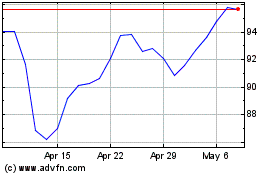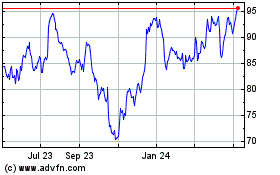Big Banks Asked to Give More Details About Trading Activity
August 02 2016 - 9:20PM
Dow Jones News
Regulators are asking big banks to provide investors with
more-detailed disclosures about their trading businesses, a push
that could peel back the curtain on a huge and volatile source of
Wall Street revenue, according to people familiar with the
matter.
Communications between Securities and Exchange Commission
officials and executives from some of the largest U.S. banks have
been informal and preliminary, the people said. But the SEC may
send comment letters to the biggest trading firms—J.P. Morgan Chase
& Co., Bank of America Corp., Citigroup Inc., Goldman Sachs
Group Inc. and Morgan Stanley—in the coming months, asking them to
give investors more details in the future, some of the people
said.
That could include requests to break out revenue from individual
products such as bonds, stocks, commodities and other, more-exotic
instruments. Currently, trading revenues are lumped together,
making it difficult for investors to figure out what is driving a
particular firm's results.
This is especially the case when it comes to FICC revenues.
These encompass fixed-income, commodities and currency products and
are the biggest source of fees on Wall Street.
In 2015, FICC revenues for the 12 largest global investment
banks came to $69.9 billion, or 9% of overall revenue, according to
data firm Coalition. For some firms, the contribution is even
higher: At Goldman, it was equal to about 22% of total revenue last
year.
"Everyone just wants to keep it close to the vest," said Steven
Chubak, a banking analyst with Nomura Holdings Inc. In quarterly
and annual filings, there is some disclosure around how banks make
markets for clients, but firms still don't divulge much information
around specific contributors to FICC-related revenues, he
added.
For investors, additional details could be telling. Knowing
which bank had good performance in, say, energy trading could help
steer an investment based on a view about the future direction of
oil prices. Or it could push banks to get out of businesses where
it becomes clear they are underperforming.
It isn't clear whether the SEC ultimately will ask for specific
disclosure items or leave it up to the banks to individually decide
what to share. A spokesman for the SEC declined to comment.
Some big banks may broadly address or acknowledge the SEC's
requests in future securities filings, some of the people familiar
with the matter said. In the more-stringent, post-financial-crisis
regulatory environment, banks typically take regulatory questions,
even informal ones, seriously and often try to be proactive.
Investors do get a sense of the overall market for particular
FICC-related products. Coalition, for instance, breaks down market
revenue by product for interest rates, credit, foreign exchange,
securitization, emerging markets and commodities.
But investors know little about the breakdown bank by bank.
Updates about underlying products are typically directional but
vague. While the SEC's push could prompt banks to disclose more
information, many in the past have resisted doing so. James D. Cox,
a professor of corporate and securities law at Duke University
School of Law, said information about particular product lines is
"highly sensitive" in part because companies don't want to attract
competition or regulatory scrutiny.
For example, Daniel Pinto, head of corporate and investment
banking at J.P. Morgan, told investors in June that interest-rate
trading in the past 12 months had been strong, while credit had
been "a bit sluggish." Goldman Sachs finance chief Harvey Schwartz
said last month that currency and commodity trading were slower in
the second quarter.
In the last 18 months, some banks have published more details in
investor presentations. For instance, J.P. Morgan at its
investor-day presentation in February provided more
product-specific details on a percentage basis. A year earlier, it
just disclosed its ranking versus the market rather than
percentages. Goldman Sachs disclosed in February 2015 the range of
percentage revenue contribution for individual products on a
long-term basis.
On the other hand, Mr. Cox of Duke added, "Investors would like
to have crisper knowledge about what the revenue streams are for
every company they think about investing in or are invested
in."
Write to Liz Hoffman at liz.hoffman@wsj.com and Emily Glazer at
emily.glazer@wsj.com
(END) Dow Jones Newswires
August 02, 2016 21:05 ET (01:05 GMT)
Copyright (c) 2016 Dow Jones & Company, Inc.
Morgan Stanley (NYSE:MS)
Historical Stock Chart
From Mar 2024 to Apr 2024

Morgan Stanley (NYSE:MS)
Historical Stock Chart
From Apr 2023 to Apr 2024
